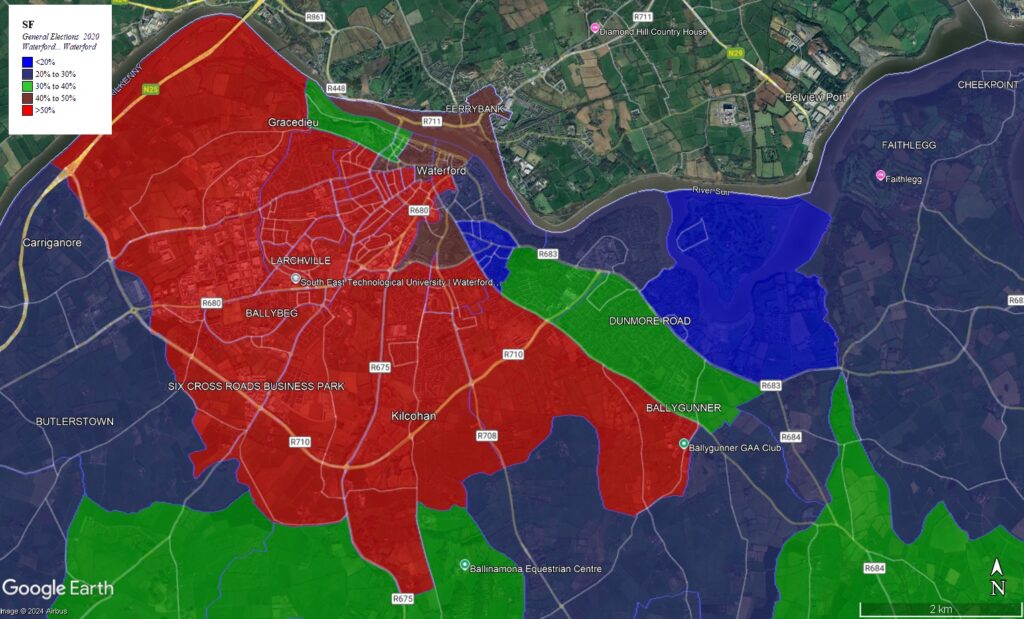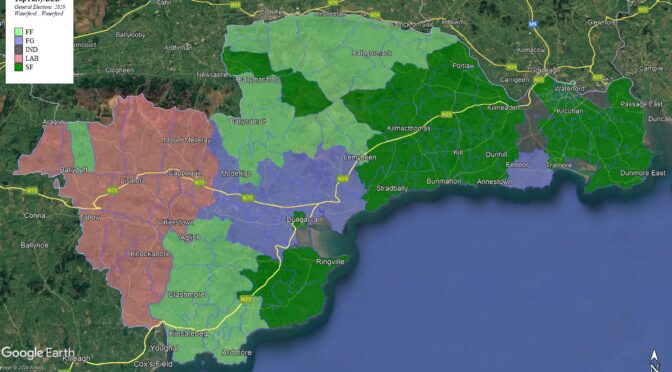HISTORY
Waterford was created as a four-seater in 1923, and has remained a four-seater ever since bar a sixteen year period between 1961 and 1977.
William Redmond, son of Nationalist Leader John Redmond, represented the constituency from 1923 until his sudden death in 1932, first as an Independent, then as the leader of the short-lived National League and finally a Cumann na nGaedhal TD. His young widow served as a Fine Gael TD for a further twenty years.
The Farmers’ Party and Labour both took seats here in 1923, but lost them in June 1927. It was to be over twenty years until Labour again won a seat. The National Centre Party’s Nicholas Wall won a seat here in 1933 and won re-election as a Fine Gael TD in 1938. Denis Heskin of Clann Na Talmhan won seats in 1943 and 1948.
Labour’s fortunes were restored by the victory of Tom Kyne in 1948. He held the seat until 1969, and then again from 1973 until 1977. Indeed, 1969 was the only occasion Fianna Fáil took a majority of the seats.
One of the notable factors of the 1977 election was the strong performance of Patrick Gallagher of Sinn Féin the Workers Party taking four and a half thousand votes. He eventually won a seat for party in February 1982 only to lose it in November running for the renamed Workers’ Party.
(The Worker’s Party remained a significant force in Waterford City politics after the split with Democratic Left in 1992 – Martin O’Regan was runner-up in 1997, and they retained council seats well into the 20th century. Independent TD John Halligan had also previously ran for the Worker’s Party).
More recently, Brian O’Shea regained a seat for Labour from 1989 to 2011, Martin Cullen won seats for the Progressive Democrats in 1987 and 1992, before switching to Fianna Fáil.
OVERVIEW
There was no change in the Waterford boundary, which was something of a surprise as an incursion into South Kilkenny was widely suspected by suspicious Cats.
Certainly, the boxes in Ferrybank just over the county border were much more closely related to Waterford City voting trends than rural Kilkenny ones – but any transfer would have had to include a significant chunk of rural South Kilkenny. Hence suspicious Cats. “First they came for our genetically superior hurlers, and we only sent indignant letters to the Boundary Commission.”
It’s worth having a look at the Sinn Féin vote in South Kilkenny in 2020 which shows how the huge support for Sinn Féin in Waterford City spilled over into its commuter belt over the border.

Sinn Féin polled 46% in the parts of Ferrybank immediately adjoining the Waterford border.
The average for Kilkenny County was 22%.
RECENT CONSTITUENCY RESULTS
The following table gives the result of every election in Waterford since 1997.
| YEAR | SEATS | Fianna Fáil | Fine Gael | Labour | Sinn Féin | Greens | Others | Inds. |
| 1997* | 4 | 35.8% 2 | 24.6% 1 | 11.8% 1 | 1.8% | 19.5%** | 6.6% | |
| 2002* | 4 | 46.3% 2 | 21.5% 1 | 13.4% 1 | 6.4% | 2.9% | 8.6%** | 0.9% |
| 2007* | 4 | 46.5% 2 | 27.4% 1 | 11.3% 1 | 6.7% | 2.1% | 3.4%** | 2.5% |
| 2011* | 4 | 14.0% | 38.1% 2 | 18.9% 1 | 9.9% | 0.9% | 2.1%** | 16.0% 1 |
| 2016 | 4 | 20.5% 1 | 28.7% 1 | 4.4% | 18.8% 1 | 4.3% | 5.3%** | 18.1% 1 |
| 2020 | 4 | 17.3% 1 | 16.5% 1 | 6.5% | 38.3% 1 | 7.4% 1 | 4.1%** | 9.9% |
NOTES:
* In elections from 1992 to 2011, a small rural area near Clonmel was in Tipperary South.
** Votes for Others includes…. 1997 – Workers Party 9.2% Progressive Democrats 6.5% National Party 1.9%, Socialist Workers Party 1.6% Natural Law 0.3%, 2002 – Progressive Democrats 4.6% Workers Party 2.7% Christian Solidarity 0.7% Socialist Workers Party 0.6%, 2007 – Workers‘ Party 3.4%, 2011 – Workers’ Party 1.6%, Fis Nua 0.5%, 2016 – Anti Austerity Alliance-People Before Profit 3.2%, Renua 1.7%, Direct Democracy 0.4%, 2020 – Solidarity-People Before Profit 2.1% Aontu 2.0%
David Cullinane has been the Sinn Féin at every election since 2002.
THE 2020 ELECTION
The 2020 election in Waterford saw a massive increase in the Sinn Féin vote that dwarfed even their most impressive performances elsewhere – this was particularly so as outside Waterford city this is a largely rural constituency.

The map above possibly doesn’t give a proper sense of the scale of their vote, so I’ve done a close-up of the City area below.

In the city the vote was even higher – everywhere in the city south and west of the Williamstown and Gracedieu roads Sinn Féin got over half the vote. In Ballybeg they got two-thirds, in nearby Lisduggan and Larchville they got three-quarters.
Waterford City encompasses three Electoral areas, each of contain adjacent rural areas – the Waterford City West area also includes the sizeable town of Tramore. The largely rural Portlaw-Kilmacthomas Electoral Area covers the centre of the constituency and in the West lie the Electoral areas of Dungarvan and Lismore
The Party breakdowns for each region are shown below.
| AREA | Sinn Féin | Fianna Fáil | Fine Gael | Green | Others | Ind. |
| West (28%) | 25% | 21% | 24% | 5% | 21% | 4% |
| Centre (17%) | 32% | 25% | 18% | 6% | 6% | 13% |
| Waterford City (55%) | 47% | 14% | 12% | 9% | 7% | 12% |
| Total | 38.3% | 17.3% | 16.5% | 7.4% | 17% | 5% |
NOTES:
* Votes for Others includes…. Labour, Aontu, Solidarity/People Before Profit
It’s worth having a look at a breakdown of the vote in the three city areas.
| AREA | Sinn Féin | Fianna Fáil | Fine Gael | Green | Others | Ind. |
| West & Tramore | 44% | 14% | 11% | 13% | 7% | 11% |
| East | 34% | 17% | 15% | 9% | 6% | 19% |
| South | 65% | 11% | 9% | 3% | 6% | 6% |
About two-thirds of the vote in Tramore- Waterford City West was in Tramore Town and surrounding rural areas – Sinn Féin got 38% in this portion followed by the Greens on 17%. In the city part of the area, Sinn Féin got 57%, followed by Fianna Fáil on 14% – no other party or group got over 10%.
In Waterford City East, about a quarter of the vote was cast in the rural areas to the east – the votes here and in the city part were broadly similar.
Finally in Waterford City South, Sinn Féin took nearly two-thirds of the vote with Fianna Fáil on 11% a distant second.
Below are the support maps of the three highest-polling candidates elected

David Cullinane’s vote may been highest in the city, but it remained at a high level in many rural areas particularly in the east. He also took 40% of the vote in western town of Dungarvan and in the Ring Gaeltacht.
Interestingly, his vote was significantly lower in the north-east of Waterford City than in surrounding areas.


Mary Butler was notably stronger in rural areas than in metropolitan or urban. By contrast Matt Shanahan seems to have drawn his vote from a coalition of rural and urban sources. He polled particularly well in the east of the city.
Also of note is that despite Fianna Fáil being only 417 votes ahead of Fine Gael on the first count, on the final count Mary Butler had 2,756 votes to spare over John Cummins. How did Fianna Fáil widen the gap?
Firstly, they did slightly better on other party terminal transfers – according to the table below Fianna Fáil had an advantage of over five hundred votes over Fine Gael on the cumulative terminal transfers from Sinn Féin, Labour and Solidarity-People Before Profit.
Secondly, Fine Gael’s candidates were too well balanced. Having an even split between your candidates is a good thing if you’re chasing two or more seats in a PR-STV contest – if you’re only chasing one it’s a bad thing. In Fine Gael’s case there was only 303 votes between their two candidates.
The maps below show the difference in vote sharing between the two parties.

Each map shows the percentage of the party vote going to the respective party’s lead candidates – Mary Butler in Fianna Fáil’s case, John Cummins in Fine Gael’s.
The map above shows John Cummins’ share of the Fine Gael vote. City-based Cummins shared the ticket with Dungarvan-based Damian Geoghegan. As can be seen, Cummins has a majority of the vote east of a line everywhere from the village of Stradbally in the south up to Clonmel on the northern border with Tipperary. In the three City Electoral areas he took 89% of the Fine Gael vote.


By contrast, in Fianna Fáil, Mary Butler completely dominated the rual centre and west of the constituency. She also – according to the tallies – narrowly bested her running-mate Eddie Mulligan in the City Electoral Areas by 51% to 49%.
This presumably didn’t bolster an amiable camaraderie between the sitting TD and her running-mate, but it ultimately aided Fianna Fáil taking a seat at the expense of Fine Gael.
DEMOGRAPHICS
I hope to add a section on Demographics later.
TRANSFERS
Below are details of the main transfers during the 2020 count.
| CNT | PTY | F.F. | F.G. | Greens | Labour | S.-P.B.P. | Aontu | Independents | NT | Total |
| 2 | S.F. | 1,101 (11%) | 693 (7%) | 1,384 (14%) | 808 (8%) | 3,208 (33%) | 377 (4%) | 2,246 (23%) | 9,817 | |
| 5 | Labour | 1,219 (26%) | 1,098 (24%) | 897 (19%) | 500 (11%) | 691 (15%) | 197 (4%) | 4,602 | ||
| 6 | S.-P.B.P. | 161 (3%) | 152 (3%) | 2,245 (41%) | 218 (13%) | 1,651 (30%) | 1,017 (9%) | 5,444 |
The biggest recipient by far of the Sinn Féin surplus was Una Dunphy of Solidarity-People Before Profit who saw her vote nearly quadruple with over three thousand transfers. However at a transfer rate of just 33%, it wasn’t enough to put her in contention for a seat. Both the Greens and Independent got enough votes to remain ahead of her.
Half the Labour vote went to Fianna Fáil and Fine Gael, and it was probably somewhat geographically slanted due the Labour candidate’s popularity in rural West Waterford.
Finally, the Solidarity/People Before Profit elimination transfer – over half of which consisted of Sinn Féin number ones – was very interesting.
Firstly, only 6% of the transfers went to Fianna Fáil and Fine Gael – 18% of the original Sinn Féin surplus went to those two parties. Clearly, Sinn Féin votes who transferred to Solidarity/People Before Profit were less inclined to transfer their vote to the Civil War parties.
Secondly, Sinn Féin transfers on the first count preferred Independent Matt Shanahan to the Greens. But the Solidarity/People Before Profit transfers (over half of which were SF votes) instead went 41% to the Greens over 30% for Shanahan.
THE CONSTITUENCY REDRAW
The Constituency Commission recommended that there be no change in Waterford which thankfully makes my task that bit simpler.

On the 2020 tally figures – a gain for Sinn Féin would be almost inevitable with the Green Party looking most vulnerable.
